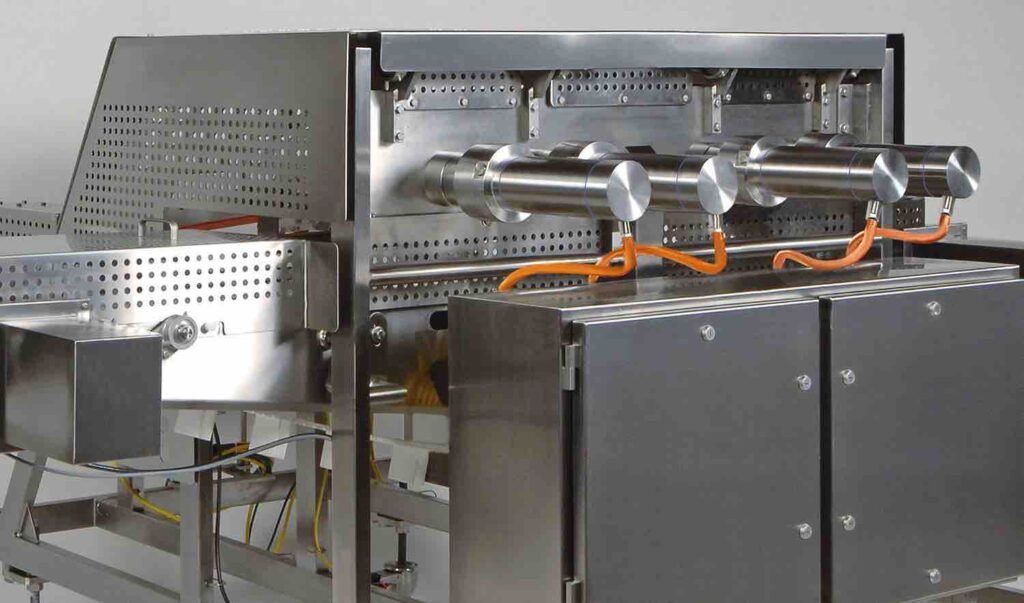Food production safety detection and rejection systems demand accuracy and control sufficient to ensure not just an effective system, but one that maintains throughput and uptime. This combines a need for optimum motor control that can integrate with an automated system with real-time data sharing to guarantee that standards are met. Gerard Bush discusses motion control system requirements to ensure food production standards are achieved
Whether controlled by regulators such as America’s Food & Drug Administration or the UK’s Food Standard’s Agency, food manufacturers are acutely aware of the need to follow stringent production regulations. For reputable manufacturers, it’s also important that they follow the obligations of hygiene and safety, not only to ensure the wellbeing of consumers and provide a high-quality product, but also to protect their brand and consumer confidence in it.
As a result of food safety demands, end-user food manufacturers rely on inspection systems. The inspection process is used both to identify and remove imperfect products from the line to ensure batch quality, but also to capture and share data to improve upstream quality control over the long term, as well as enabling downstream product traceability.
Today’s demands mean inspection of every single item in a batch, and for food manufacturers to ensure safety but maintain throughput, inspection equipment such as machine vision systems, X-ray, metal detection and weighing sensors are automated to the production line. Imperfect products are then using flaps, pushers and arm diverters. Control over the motion required to actuate and accurately position equipment such as sensor gantries and inspection systems is vital in order for the detection and rejection systems to effectively operate.
Direct drive motor technology is often favoured in these applications because of the high dynamic performance it provides. Not requiring a coupling between the motor and the load, a direct drive motor minimises lag or backlash associated with a device such as a gearbox. Resulting performance advantages include load acceleration, reduced system inertia, and higher precision, as well as reduced power consumption. Another advantage is the highly compact footprint of the motor itself, which combined with the removal of the transmission, creates a smaller machine. As transmission devices are prone to wear, removing the transmission also creates a more robust, reliable system.

Direct drive motors are available with a housing, enabling them to be easily installed into an existing machine. Alternatively, a frameless direct drive motor comprises the rotor and stator alone, meaning that they can be designed into a machine to reduce footprint and improve flexibility, particularly relating to installation options.
Kollmorgen has been involved with direct drive motor design since the birth of the concept and today the company’s engineers combine with partners such as INMOCO, as well as directly with the OEMs themselves, to develop motion solutions for applications including food manufacture safety systems. Kollmorgen’s framed motor range includes both housed and cartridge models that combine the advantages of direct drive in an easy-to-install package. Combined with high torque density, control is ensured with an integrated high-resolution feedback device.
Alternatively, Kollmorgen’s frameless designs are embedded directly within a machine, using the machine’s own bearings to support the rotor. The advantages include high-performance motion control combined with a long life, maintenance-free motor. The frameless design also means that an exact fit for the application can be used, enabling compact and efficient machine design and also helping create a faster machine build.
The inherent benefit of direct drive motors, particularly frameless versions, is the ability to customise according to specification requirements. Working with integration partners such as INMOCO, Kollmorgen’s direct drive motors cover an extensive range and are flexible enough to enable a range of modifications to ensure the best fit. Customisation options mean that features such as leads, windings and stack lengths can be specified to suit.
Combined with control accuracy, data sharing is also key for food manufacturers in order to demonstrate quality, improve future processes and enable traceability. Cloud-based systems enable the advantages of Industry 4.0 and Kollmorgen’s direct-drive motors can communicate with the company’s AKD2G drives, which also include built in functional safety. The drives share data in real-time to communicate status, diagnostics and predictive maintenance, providing information to enhance process productivity and reliability.
Integrating AKD2G drives, process data can be relayed to the controller as part of the Kollorgen Automation Suite, and Kollmorgen’s controllers also support I/O terminals and HMI integration. This means that real-time production data can be managed and recorded, as well as being shared where required thanks to cloud connectivity. This provides visibility at all stages across the process to ensure that safety standards are maintained.
Gerard Bush is with INMOCO.
 Engineer News Network The ultimate online news and information resource for today’s engineer
Engineer News Network The ultimate online news and information resource for today’s engineer





